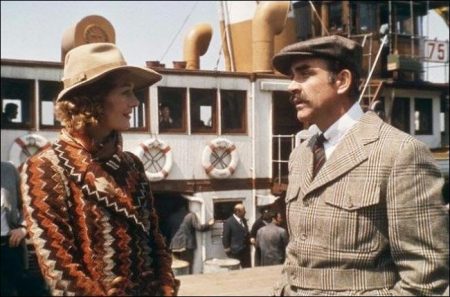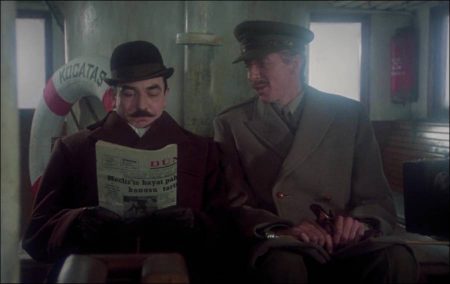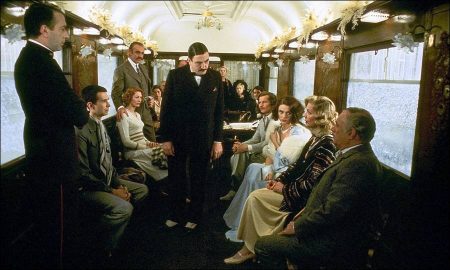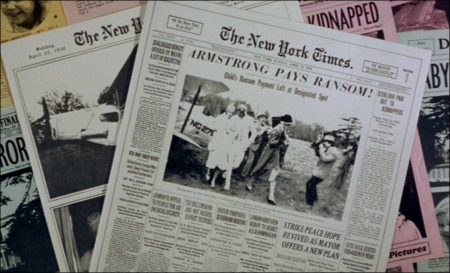Murder on the Orient Express movie storyline. Hoping for a well-deserved and much-needed rest, the renowned Belgian detective, Hercule Poirot, returns to England aboard the luxurious Orient Express, along with an eclectic array of high-class passengers. But when the rapid locomotive’s journey comes to a halt due to a massive avalanche, the moustachioed detective will use the unfortunate mishap to his advantage, to investigate the brutal murder of a fellow traveller. Inevitably, in a confined space where everyone is a suspect, Poirot must work fast before the unknown killer strikes again, as a strange coincidence links the remaining commuters together. Is the methodical detective worthy of his reputation?
Murder on the Orient Express is a 1974 British mystery film directed by Sidney Lumet, produced by John Brabourne and Richard Goodwin, and based on the 1934 novel of the same name by Agatha Christie. The film features the Belgian detective Hercule Poirot (Albert Finney), who is asked to investigate the murder of an American business tycoon aboard the Orient Express train. The suspects are portrayed by an all-star cast, including Lauren Bacall, Ingrid Bergman, Sean Connery, John Gielgud, Vanessa Redgrave, Michael York, Jacqueline Bisset, Anthony Perkins and Wendy Hiller. The screenplay is by Paul Dehn as well as an uncredited Anthony Shaffer.
The film was a commercial and critical success. It received six nominations at the 47th Academy Awards: Best Actor (Finney), Best Supporting Actress (Bergman), Best Adapted Screenplay, Best Original Score, Best Cinematography and Best Costume Design. Of these nominations, Bergman was the only winner.
The murder, clues, supect and motive
The murder
Having sorted a matter out in the Middle East, detective Hercule Poirot (Albert Finney) is returning to England aboard the Orient Express. During the journey, Poirot encounters his friend Bianchi (Martin Balsam), a director of the Compagnie Internationale des Wagons-Lits, which owns the line. The train is unusually crowded for the time of year: every first-class berth has been booked.
Shortly after the train’s departure from Istanbul, a wealthy American businessman, Ratchett (Richard Widmark), tries to secure Poirot’s services for $15,000 since he has received many death threats, but Poirot finds the case of little interest and turns it down. That night the train is caught in heavy snows in the Balkans. The next morning Ratchett is found stabbed to death in his cabin. Poirot and Bianchi work together to solve the case.
They enlist the help of Dr. Constantine (George Coulouris), a Greek medical doctor who was travelling in another coach with Bianchi as the only other passenger and thus not a suspect. Pierre Michel (Jean-Pierre Cassel), the middle-aged French conductor of the car, also assists the investigation, as well as being a suspect. Poirot soon discovers that Ratchett was not who he claimed to be. The victim’s secret past indicates a clear motive for murder, even justification, but who was the killer?
Clues
Dr. Constantine’s examination of the body reveals that Ratchett was stabbed 12 times. Some wounds were slight, but at least three of them could have resulted in death. The stopped watch in the victim’s pocket, as well as Poirot’s reconstructed timeline of passenger activities the night before, indicate that Ratchett was murdered at about 1:15 a.m.
The train had stopped, surrounded by fresh snow, before that time. There are no tracks in the snow and the doors to the other cars were locked, so the murderer is almost certainly still among the passengers in the coach in which Ratchett was killed. Most importantly, Poirot realizes that Ratchett was in fact a gangster called Cassetti. Five years previously, Cassetti and a henchman kidnapped and murdered Daisy Armstrong, the baby daughter of a wealthy British Army Colonel who had settled in America with his American-born wife.
The body was found after the ransom had been paid. Overcome with grief, the pregnant Mrs. Armstrong went into labor early and died while giving birth to a stillborn baby. A maidservant named Paulette who was wrongly suspected of complicity in the kidnapping committed suicide. Colonel Armstrong, consumed by these tragedies, later killed himself as well.
Cassetti’s accomplice was arrested and executed, but Cassetti himself fled the country with the ransom, as he was only revealed to be the leader on the eve of the execution. Having established these facts, Poirot, Dr. Constantine and Bianchi summon the other passengers one by one and proceed to interrogate them. (The fictitious Armstrong case was inspired by the real-life kidnapping of aviator Charles Lindbergh’s child.)
Suspects
The thirteen suspects are: Hector McQueen (Anthony Perkins), a tall, young American man, the victim’s secretary and translator; Edward Beddoes (Sir John Gielgud), the victim’s British valet; Mary Debenham (Vanessa Redgrave), a young British woman, returning home to England after working as a teacher in Baghdad; Colonel Arbuthnott (Sean Connery), a British officer in the British Indian Army returning to England on leave; Princess Natalia Dragomiroff (Wendy Hiller), an elderly Russian royal; Hildegarde Schmidt (Rachel Roberts), a middle-aged German woman, the Princess’ personal maid; Count Rudolf Andrenyi (Michael York), an aristocratic Hungarian diplomat.
The other suspects are Countess Elena Andrenyi (Jacqueline Bisset), née Grünwald, his beautiful young wife; Greta Ohlsson (Ingrid Bergman), a middle-aged Swedish missionary returning to Europe on a fund-raising trip for her mission in Africa; Mrs. Harriet Belinda Hubbard (Lauren Bacall), an older, fussy, very talkative American pluri-widowed socialite; Antonio (Gino) Foscarelli (Denis Quilley), an exuberant Italian American car salesman from Chicago; Cyrus B. “Dick” Hardman (Colin Blakely), a Pinkerton’s detective masquerading as a talent agent; Pierre-Paul Michel (Jean-Pierre Cassel), the French conductor of the sleeping car.
Motive
Poirot soon comes to realise that all the suspects were connected to the Armstrong family and had reason to seek revenge for the tragedies that followed the kidnapping. Some openly admit their connections to the Armstrongs, while other ties must be uncovered by Poirot.
McQueen was the son of the District Attorney who prosecuted the case and was very fond of Mrs. Armstrong; Miss Debenham was Mrs Armstrong’s secretary; Beddoes was Colonel Armstrong’s army batman and the family butler; Col. Arbuthnott was an army friend of Col. Armstrong; Princess Dragomiroff was Sonia Armstrong’s godmother; Miss Schmidt was the Armstrongs’ cook; Miss Ohlsson was Daisy’s nursemaid; Foscarelli was the Armstrong’s chauffeur; Hardman was, at the time, a policeman who was in love with Paulette; Michel was Paulette’s father; Countess Andrenyi was Mrs Armstrong’s sister; Mrs Hubbard was Mrs Armstrong’s mother; Count Andrenyi was Mrs Armstrong’s brother in law.
Ratchett was sedated by Beddoes and McQueen. Each of the passengers then stabbed him in turn. Poirot presents this explanation for the murder to the assembled passengers, describing it as the “complex” solution to the crime. Yet he also offers another explanation, a “simple” one. In the course of the inquiry evidence has been found of an intruder on the train, who may have murdered Ratchett and then escaped evidence planted by the suspects.
Poirot suggests that Ratchett/Cassetti may have been involved with the Mafia and murdered as the result of a feud. He leaves it to Bianchi, director of the line, to decide which explanation to present to the local police. Bianchi decides that this “simple” solution will be enough for the local police and that Ratchett deserved everything he got. A cover-up is therefore instigated. Poirot is satisfied that justice has been done, though he does admit to a struggle with his conscience.
Murder on the Orient Express (1974)
Directed by: Sidney Lumet
Starring: Albert Finney, Lauren Bacall, Ingrid Bergman, Martin Balsam, Jacqueline Bisset, Jean-Pierre Cassel, Sean Connery, Wendy Hiller, Anthony Perkins, Vanessa Redgrave
Screenplay by: Paul Dehn
Production Design by: Tony Walton
Cinematography by: Geoffrey Unsworth
Film Editing by: Anne V. Coates
Costume Design by: Tony Walton
Art Direction by: Jack Stephens
Music by: Richard Rodney Bennett
MPAA Rating:
Distributed by: Paramount Pictures
Release Date: November 24, 1974
Views: 166




